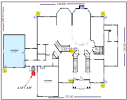I recently signed new home and one of the decisions I made was if I needed security cameras and locations. At the time I forgot about this forum . But when checking for NVR prices on Slickdeals user mat2000 there ( I think @mat200 in this forum) referred to ipcamtalk. So came here started reading cliff notes and one bullet pointed me to this post where it is suggested by @Fastb and @mat200 to add as many pre-wires as possible. Deadline to make changes for pre-wiring was last week, but I think I can still request the changes if it is needed. So this is kind of urgent.

Now about my decision, to pre-wire each cable builder was charging $300 (I thought that was ridiculous) , I still budged and picked 4 corners for CAT6 cables to be wired. When I searched online, I learned I can use one CAT6 cable for 2 cameras using a splitter like this one . So I thought, with two front entry doors will have two cameras (another upgrade I added is to add another CAT6 cable for doorbell for second entry door) and main entry door comes with low voltage doorbell pre-wiring as a standard from the builder. So I figured 8 POE (4x2) cameras plus two doorbell cameras will be enough. Also, I added one conduit (Future Proof Conduit from NVR location to Attic). But when I read above mentioned post, I am wondering if I made a mistake. Is it worth to add more CAT6 cables. Shall I request a change?
I don't know if it matters, but this house is generally in a safe neighborhood with walking score = 1. At least 10 minutes drive from anything.
I appreciate all your help in advance.

Now about my decision, to pre-wire each cable builder was charging $300 (I thought that was ridiculous) , I still budged and picked 4 corners for CAT6 cables to be wired. When I searched online, I learned I can use one CAT6 cable for 2 cameras using a splitter like this one . So I thought, with two front entry doors will have two cameras (another upgrade I added is to add another CAT6 cable for doorbell for second entry door) and main entry door comes with low voltage doorbell pre-wiring as a standard from the builder. So I figured 8 POE (4x2) cameras plus two doorbell cameras will be enough. Also, I added one conduit (Future Proof Conduit from NVR location to Attic). But when I read above mentioned post, I am wondering if I made a mistake. Is it worth to add more CAT6 cables. Shall I request a change?
I don't know if it matters, but this house is generally in a safe neighborhood with walking score = 1. At least 10 minutes drive from anything.
I appreciate all your help in advance.
As an Amazon Associate IPCamTalk earns from qualifying purchases.
